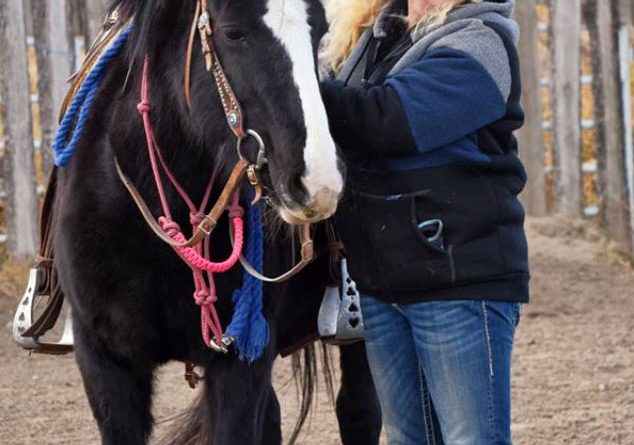Cheadle woman tames Alberta’s wildies
By Miriam Ostermann, Associate Editor


Photo Courtesy of Darla Connolly
The Cheadle local wasn’t always so courageous. Nine years ago, she found a bay horse online in Camrose, named Dante, and made up her mind she had to bring it home, despite not having adequate shelter or transportation. It took three hours to get him inside the trailer and another six months before Connolly found him a new home and settled for a calmer horse to build up her confidence.
“I didn’t have a truck, I didn’t have a trailer, I didn’t have a place to put him; I just decided I was getting that horse come hell or high water,” she said.
“I always wanted a wild horse because of the mystery and the fantasy. I never thought I’d be taking a horse out of the wild and everything that goes along with it. I just wanted a wild horse. But then once I got to know more about them and how they’re captured I obviously didn’t want one. I wasn’t going to catch one and I didn’t want to take one from its family.”
Three years ago, Connolly heard about the government’s cull of Alberta’s wild horses that were being sold at auction. It was love at first sight. Connolly took home a black, headstrong, biting and kicking 15-year-old pregnant mare named Scarlet. This time Connolly was prepared. In only three days, Scarlet would follow commands and walk into the trailer on her own.
Now, Connolly, who owns XL Ranch Horse Training in Cheadle, is the proud owner of three of Alberta’s wildies: Scarlet, and her offspring Tundra and Corie, which are all part of a Spanish bloodline that dates back to a draft horse breed, the Altai, which is over 300 years old.
“They’re better because they’ve never been touched, and they’ve never had a bad hand on them; they’ve never had mistreatment other than being captured, but once they trust you they’ll do anything for you,” Connolly said. “I love just seeing the change, seeing the difference from being a rabid Dobermann in a trailer trying to eat me, to now little two-year-old kids riding her. That’s what I like to see – from this crazy to this beautiful calm. Once they trust you it doesn’t take that long. These horses need time and I think that’s why most people don’t have them anymore because they just don’t put in the time that they need. They say, ‘30 days is up, this horse is no good.’”
Over the years, Connolly taught herself by reading books, watching videos and going to clinics. Her reputation has kept her busy with training an average of four horses a month coming from as far away as the United States. The animal lover was also nominated for Heroes of the Horse, for which she received over 1,000 votes.
Connolly’s wildies have participated in gymkhanas and most recently rode in the Langdon Days parade. She said because they are good at conserving their energy in the wild, she finds their nature lazy and calm. Their features also differ from domestic breeds, with shorter necks, thick buttocks and legs, and incredibly thick manes.
The province estimates roughly 880 feral horses roam the Rocky Mountains foothills area, enough to cause damage to grasslands used for livestock and grazing wildlife. Wild horses are protected under the Stray Animal Act that prevents them from being shot, hunted or captured. Yet an annual capture season can be declared by the provincial government where licensed horse trappers are allowed to capture and remove the animals from their environment in order to maintain manageable population levels. Earlier this year, the Alberta government agreed to consider proposals from other non-profit organizations to conduct contraceptive programs in hopes of replacing government captures and culls. The Wild Horses of Alberta Society (WHOAS) is a not-for-profit society that has been working on solutions for wild horse population management, protection and adoption programs.
Connolly has also found forever homes for some of the horses she’s adopted and trained. While some call her a horse-whisperer, the trainer can’t explain the connection she feels with animals.
“Weird things happen to me, animals know me,” she said. “I went to Africa and I would stand out in the middle of the Serengeti and there would be giraffes, 10 of them, behind me and they would not move, and zebras. And then we turn around for my friend to take a picture and they would scatter. I’m sure I’ll die by animal one day, because I’m not afraid of them.”
